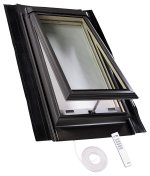Search engine visitors - click here to access entire "$ensible Home" web site
Click here to see a descriptive illustration showing several new designs of skylights and skylight/balconies.
Dear Jim: Our electric bills are high, probably due to so many lamps being on. I have always liked natural light and skylights. Are venting skylights as efficient as standard ones and is glass or plastic better? - Rita M.

A: The natural light from adding a skylight can totally transform the feeling you have in a room and can cut your electric bills as you mentioned. Lighting is one of the primary consumers of electricity in many homes, not to mention all the bulb replacement costs over the years.
Unless you have allergies and must air-condition continuously, a venting skylight is your most efficient choice. It is basically a casement window mounted in your ceiling. Since the hot air naturally rises, opening a venting skylight will exhaust this hot air and create a comfortable breeze inside your home without air-conditioning.
A venting skylight will cost somewhat more than a standard fixed skylight, but the air-conditioning savings should payback the additional cost over its life. Good-quality brands are well-made with weatherstripping and are not more prone to leakage during rain storms than a fixed skylight.
The two control options you have are a manual crank or an electric motor to operate the skylight. A long crank handle is easy to operate, but if your budget allows, select one with an electric motor. The motor operates for only a few seconds, so it uses a negligible amount of electricity.
Many of the electric models include a hand-held remote control similar to a television. With this convenience, you will tend to open and close the skylight more often for the optimum energy savings and comfort. If the skylight faces south or west, select a model which is also wired for solar screening. Using the same remote, the screen slides over the skylight.
For do-it-yourselfers, select a self-flashing model. To install this, just cut a hole in the roof and mount the skylight. Curb-mounted skylights require you to flash it to eliminate leaks. The least expensive option is to build your own skylight curb and install the flashing. If you don't have a sloped cathedral ceiling, you will have to build a lightwell to the roof.
Glass is often preferred, but it is more expensive than plastic. Plastic, especially triple-pane is as efficient as glass, but it does not provide as clear a view. In some rooms though, the view to the sky is not important and just getting natural light is the goal. If you want glass, select double-pane low-e argon glass as a minimum or add laminated glass to block more fading rays.
One skylight design converts into a balcony and is ideal for steep roofs. The skylight is hinged at the top. When it swings open, a bottom section with a safety rail extends out so it becomes a balcony you can stand in.
Instant Download Update Bulletin No. 673 - buyer's guide of 11 skylight manufacturers listing frame materials (vinyl clad, aluminum clad, fiberglass, vinyl, aluminum), shapes with illustrations (rectagular, square, dome, custom shapes, diamond-shaped, etc.), flashing and glazing options, accessories available, features, prices, sizing chart, illustrations of several models and instructions for making a skylight lightwell.
Dear Jim: I have heard of equipment to use the waste heat from air conditioners to heat the hot water for free. My refrigerator gives off a lot of heat. Can this be used to heat water too? - Randy J.
A: You are correct about using the waste heat from air conditioners during summer to assist the water heater. It is effective and also makes the air conditioner operate for efficiently.
Although you can feel the warm air coming up from the back of a refrigerator, it is really not enough heat to justify the expense of a system. Also, it would be difficult to capture the warm air from the kitchen.
Please include $3.00 and a self-addressed stamped business-size envelope.